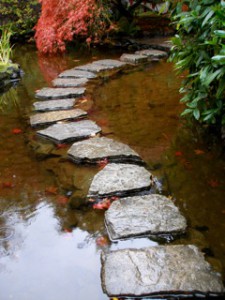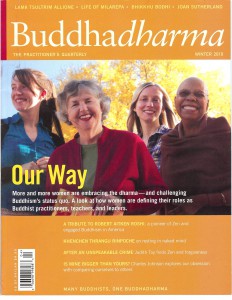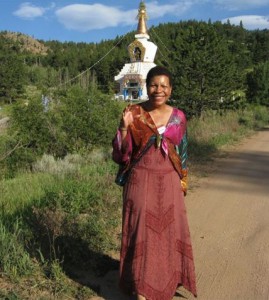Friday
Featured StoriesBodhisattva Chaplain
by Fay Octavia Elliott
As earth and the other elements, together with space,
Eternally provide sustenance in many ways for the countless sentient beings,
So may I become sustenance in every way for sentient beings
To the limits of space, until all have attained nirvāṇa.– Bodhisattva Vow
When I first began practicing meditation, I thought that I somehow could escape from my life and my problems. Ever since I first heard of enlightenment, I wanted to become enlightened so not have to spend any more lifetimes in this world of suffering and unhappiness. I hoped to transition directly to a new world. In 1995, my husband Michael and I were in a major automobile accident which resulted in my brain injury and his death in 1997. The following year a lump in my breast was finally diagnosed as breast cancer. Then in 2005, my mother died. I attended both Michael and my mother for many months leading up to each death. To make sense of facing death and caring for dying family members, I decided to become a hospice volunteer. It was in hospice training that I learned about chaplaincy and decided to attend Naropa University’s Master of Divinity program to become a Buddhist hospice chaplain.
After my cancer diagnosis, on some level I believed that would be my way out. Then I remembered that I would just be reborn and face the same issues again. So I decided I needed to stay long enough to become enlightened in this lifetime. How could I have known that with the decision to become a hospice chaplain, my path would draw me inexorably towards not only wanting to become enlightened for my sake but also for the benefit of all beings and taking the bodhisattva vow to keep returning to a human rebirth until all beings have attained enlightenment.
Back in 1999, I attended an interfaith seminary program sponsored by a local church. The first day of class, we were in a room with a labyrinth surrounded by interfaith shrines from many different traditions. We walked around the room, stopped and prayed at each shrine and then walked the labyrinth. While I was walking the labyrinth, I heard what appeared to be the voice of Jesus say, “You are a bodhisattva.” At first it seemed strange that this idea would be introduced to me by Jesus. The religious scholar Karen Armstrong gave me a context for this in her book on compassion when she describes how Saint Paul, the earliest extant Christian writer, quoting an early Christian hymn, presents Jesus as a bodhisattva figure who refused to cling to the high status befitting one made in God‘s image and lived as the servant of suffering humanity. By then I had been praying the Prayer of Saint Francis daily for over five years. Something in me seemed to resign to what seemed inevitable. It would be many years before I found the Shambhala Buddhist path and took the bodhisattva vow.
What is the path of the bodhisattva and why do I refer to them as chaplains?
Chogyam Trungpa Rinpoche defined the word bodhisattva as “…he who is brave enough to walk on the path of bodhi.” He goes on to say, “Bodhi means awake, the awakened state.” This is not to say that the bodhisattva must already be awake; but he is willing to walk the path of the awakened ones. The bodhisattva vows to delay his complete and full enlightenment (Buddhahood) until all sentient beings attain enlightenment. She is agreeing to return over and over again to assist these beings.I was delighted to hear Andrew Holocek say in a class on death and dying, that by attaining Buddhahood, we could be of even more benefit to beings. So why delay? Chogyam Trungpa Rinpoche reinforces this notion. Almost by giving up trying to attain something but by continuing on the path, the bodhisattva arrives at Buddhahood. He always lives life thoroughly and fully, and the result is that, before he realizes where he is, he has attained full enlightenment. But, his unwillingness to attain enlightenment continues, strangely enough, even after he has reached Buddhahood. Then compassion and wisdom really burst out, reinforcing his energy and conviction.
By following the career path to become a chaplain, we are choosing to be of spiritual benefit to the people we serve whether we serve in a spiritual community, hospital, prison, school or some other setting. As bodhisattva chaplains we are called to a more extensive role in the world. The bodhisattva is in spiritual service to all sentient beings without exception and regardless of setting. Her chaplaincy includes not just service to a few human beings in a limited setting, but extends to non-human sentient beings as well. Lama Surya Das describes that a real bodhisattva has pure intentions toward everyone and everything. There is no selfishness, no neurosis, no rough edges, and no hidden agenda. This is the ideal we strive for and cultivate when we take the Bodhisattva‘s altruistic vow.
The key seems to be taking Buddhism to the streets, to the places where people live and work. Throughout the Western world Buddhism has found a foothold. It‘s notions of personal individual practice and liberation combined with social action and deep compassion for the suffering of the world has given Buddhism a new vigor and freshness. It has also brought a new way of being to the many activists movements such as peace, disarmament, and ecology. Unlike the old notion of a benevolent monarch ruling the world and implementing change from the top down, this new Buddhism is bubbling up from the bottom and engaging the people in becoming “the change they want to see in the world.” In taking a vow to be of benefit to all beings, the bodhisattva is called to practice not just on the cushion but to a practice of engagement in relieving all the forms of suffering in the world, a universal form of chaplaincy.~~
Having just completed her degree at Naropa University, Fay Elliott is now heading off to Shambhala Mountain Center to be the first chaplain in residence there. For more information about Shambhala Mountain Center, click here. For more information about the Master of Divinity program at Naropa University, click here.








Oct 24, 2013
Reply
I often find myself smiling that Mona Lisa/Chogyam Trungpa Rinpoche smile…The one that shows you’re Awake and just messin’ with folks…sometimes I create new labels for an almost new Mindset…Take for instance, the idea of Mahayana Christianity…” Am I my brother’s keeper?…..Absolutely! ” As ye sow so shall you reap…”=karma…
The author of the book Jesus’s Godama Sources claims that most scholars are naturally prejudicial towards, and financially dependent on, the faith or creed of their home country and points to the prejudicial language of the philologist and scholar of comparative mythology/religion Max Muller who stated: “Our natural inclination would be to suppose that the Buddhist stories borrowed from our Christian sources and not vice versa. But here the conscience of the scholar comes in. Some of these stories are found in the Hinayana Buddhist Canon and date, therefore, before the Christian era. The Commonality? Karuna=Compassion…
Suggestions have been made that Buddhism may have influenced early Christianity.[29] Buddhist missionaries, sent by Emperor Ashoka to India, Ceylon, Syria, Egypt and Greece, may have helped prepare for the ethics of Christ.[30][31] Gnostics (a small number of sects) are not considered part of mainstream Christianity and some have been declared heretical. However, Elaine Pagels proposes Buddhist influences on Gnosticism. Pagels suggested that there are parallels with teachings attributed to Jesus Christ and teachings found in Eastern traditions, but concludes that these parallels might be coincidental, since parallel traditions may emerge in different cultures without direct influence. However, no evidence of a connection to Buddhism in Gnosticism has been shown to exist in mainstream scholarship. Buddhist Jack McQuire has suggested that in the 4th century, Christian monasticism developed in Egypt, and it emerged with a corresponding structure comparable to the Buddhist monasticism of its time and place.
The suggestion that an adult Jesus traveled to India and was influenced by Buddhism before starting his ministry in Galilee was first made by Nicolas Notovitch in 1894 in the book The Unknown Life of Jesus Christ which was widely disseminated and became the basis of other theories. Notovitch’s theory was controversial from the beginning and was widely criticized. Once his story had been re-examined by historians, Notovitch confessed to having fabricated the evidence
Communicating Christ in the Buddhist World by Paul De Neui and David Lim (Jan 1, 2006)
Pagels, Elaine (1979, repr. 1989). The Gnostic Gospels. New York: Random House.
The Oxford Handbook of Eschatology by Jerry L. Walls (Apr 16, 2010) ISBN 0199735883 page 151
Jump up ^ The Oxford Companion to Christian Thought by Adrian Hastings, Alistair Mason and
Hugh Pyper (Dec 21, 2000) ISBN 0198600240 page 206
Thank you so kindly for listening to my diatribe….hehehe.
Sep 16, 2013
Reply
Namaste and again Thank you for the mahayana path. My greatest wish is to see every human beings to take the bodhisattva vows wether for one or as many lifetimes regardless of greed dogma and religion. May all beings benefit from this info and may we continue to work toward the end of suffering toward enligthenment…
Sep 13, 2012
Reply
Fay
What a great and inspiring story. Thank you for sharing it, and your heart, with the world in this way.
Be Well
Lisa
Jun 10, 2012
Reply
Dear Fay,
Thank you for your deep service to our community and to our world. You are truly an inspiration and a whole lot of fun, as well. I’m so pleased that you’ll be serving in the context of the Shambhala Mountain Center. It’s such a beautiful and sacred place. I have no doubt that you and the Mountain will serve one another well, and together, will serve all those who are fortunate enough to visit there.
Thanks for the inspiring, articulate and inclusive article which so beautifully clarifyies the path.
Love,
Claudia